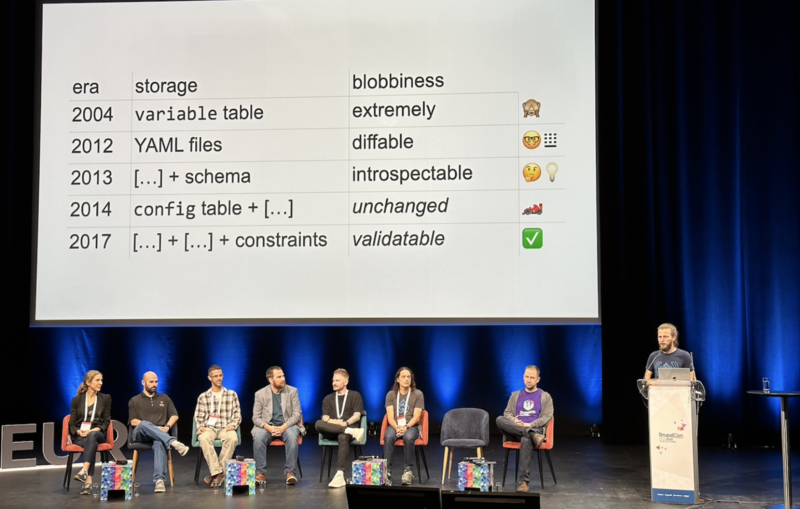The value of open source isn’t simply free software. Open source brings the benefit of diverse perspectives. Contributors around the world offer their time and skill to make Drupal better, improving the end-product for everyone because it takes into account use cases and innovations that you might not have considered yet.
In the past year alone 7,800+ people contributed to launching Drupal 10, improving core features, and improving the library of contributed add-ons available.
The Drupal Association and the Drupal community work hard to foster this culture of contribution:
- Drupal’s Open Web Manifesto and Values and Principles uphold a strong culture of collaboration, experimentation, and iterative improvement.
- Drupal strategic initiatives encourage and empower contributors to channel their efforts into priority projects that drive the most meaningful, inclusive growth. You can find open Slack channels for each initiative on the Drupal Slack.
- Ease of contribution is improving thanks to ongoing efforts such as the Gitlab Acceleration initiative, which aims to streamline the code contribution process.
- Support for contributors is available in the form of the contributor guide, getting started page, contribution events, and DrupalCon contributor workshops.
As the Promote Drupal initiative lead, I’m privileged to work alongside a fantastic group of contributors—including designers, writers, marketers, and strategists—to enhance the Drupal brand and expand its reach. We aim to increase Drupal adoption, creating an even bigger community that achieves ever-better things.
There are many more Drupal initiatives, each with its own dedicated team. In October, I had the pleasure of presenting alongside several core initiative leads at the 2023 DrupalCon Lille in France.
In this article, I’ve shared key updates from the other core initiative leads. Read on to explore what they’re working towards, their challenges and progress, and how you (yes, you!) can get involved.
How are Drupal Initiatives Created?
Before we dive into updates from each initiative, let’s take a quick look at how Drupal initiatives are formed.
People within the Drupal community come together to work on various projects including Drupal core, contributed modules, themes, and distributions. Some of this work is organized as initiatives, where a group of people focus on a particular area of concern.
A Drupal initiative has three main stages:
- Proposed – the initiative is proposed by Dries or the Drupal community members
- Planned – detailed plans, goals, and a team are put together for the initiative
- Active – the initiative team begins the real work of delivering on its goals
Most initiatives are community initiatives, but a few become strategic initiatives. Strategic initiatives are chosen by Dries Buytaert, Drupal’s founder and Project Lead, according to the following criteria:
- The initiative will result in a breakthrough for Drupal
- It’s clearly linked with solid data, market research, and Drupal’s vision
- It’s high priority work that requires focused resources
- It involves collaboration among many stakeholders
Now let’s take a look at the great things being achieved by some of Drupal’s active initiatives, as well as the hard work that’s being done behind the scenes.
Admin UI Initiative
Drupal is well-known for empowering users to create complex solutions. But historically, this power has come hand-in-hand with a steep learning curve. As a result, Drupal has higher barriers for entry and many users aren’t leveraging its full potential.
The Admin UI initiative aims to make Drupal the tool of choice for ambitious site builders by creating a simpler, more intuitive user experience. Specific goals include:
- Improving fields functionality
- Building a better navigation experience
- Modernizing the UI design and information architecture
- Implementing features that are successful in Gin (an experimental admin theme)
- Providing more customizations such as accent colour and darkmode
- Developing the Project Browser module
- Implementing same-page preview for content editors
The work will be underpinned by thorough user research, including user interviews and personas. Could you help? Check out the following Drupal Slack channels for more information: #admin-ui, #dashboard, #field-ux, #gin, #layout, #preview, and #project-browser.

Admin Toolbar Initiative
Drupal's administration menu, known as "the toolbar”, has remained largely unchanged over the years with only minor adjustments to its look and feel. The Admin Toolbar initiative aims to offer a better experience for content editors and site builders and streamline how they use Drupal.
Specific features of the new toolbar will include:
- New information architecture
- Smooth animations
- Consistent spacing
- Modern design
- Accessibility beyond WCAG standards
The Admin Toolbar team has already completed a considerable amount of design, testing, iteration, and prototyping work. As a result, the new toolbar features a collapsible and vertical layout that has received positive feedback from users.
There’s still plenty of work to be done and the team is looking for contributors who can help redo the content creation menu, conduct further UX and accessibility testing, manage the alpha release, and fix bugs. Check out the navigation project and join the #admin-ui channel in Drupal Slack to get involved.
Config Validation Initiative
Configuration management was introduced in Drupal 8, making it easier to deploy and track changes to configuration in a controlled way, along with changes to code. It separated content and configuration management. For example, you can move improvements to a blog content type from a development environment to the live environment, without touching the blog posts on the live website.
Drupal 8 also introduced validation constraints and an API-first approach. But there was a missing link: it wasn’t possible to modify configuration through Drupal's REST or JSON:API, because only content entities had validation constraints.
The Config Validation initiative aims to close this gap, with the ultimate goal of making 100% of Drupal core configurations validatable and making configuration management more robust. This will make it possible to ensure that configuration changes can be made cleanly through an API, and give more visibility to conflicts when developers are collaborating on related configuration.
These improvements lay essential groundwork for smoother deployments, automated updates, and headless applications. While it isn’t a strategic initiative itself, it will bolster several strategic initiatives like Recipes and Automatic Updates.
As recently as December 2022, only 4.5% of all config types were fully validatable. Today, that figure has increased to an impressive 8.8%. What’s more, the percentage of partially validatable config types has gone up from 27% to 53%!
Interested in contributing to the Config Validation initiative? Follow issues tagged with configuration schema and validation, and check out tools like the Config Inspector module.
Localize Port Initiative
Localize.drupal.org is a platform where people can help translate Drupal’s interface into more than a hundred different languages. This is really useful for ensuring that the admin UI is translated to the language of your content authors. It plays a central role in making Drupal accessible to people across the globe, leading to greater inclusivity and diversity of users. It means that you can install Drupal in the language of your choice and immediately see the interface in your language.
The Localize Port initiative is overhauling the Drupal Translations website with the aim of uniting translation communities and streamlining the contribution process. It’s also working to give translators more recognition, ensuring they’ll have contribution credits added to their drupal.org profiles for translation activity.
The initiative is currently in the first phase: migrating the site from Drupal 7 to Drupal 10. The second phase will bring new improvements to the platform such as an enhanced UI, statistics, and a multilingual glossary tool. There are also plans to bring back the Localization Client module, which enables users to submit translations from the local instance.
Could you help progress the Localize Port Initiative? The team is welcoming contributors to work on the initial port phase and the improvements phase. Documentation is available, including onboarding instructions and a roadmap. Check out the #localize channel on Drupal Slack to learn more.

GitLab CI Initiative
Along with improvements to Drupal itself, this initiative aims to create a better developer experience for contributing to Drupal. By making it easier to write, test, and deploy code, we encourage developers to get involved and make their work more efficient. One tool that modern developers expect is CI/CD (continuous integration and continuous delivery). GitLab CI is a popular tool for enabling CI/CD pipelines that enables automated testing to validate changes to code and ensure code quality. This includes compatibility tests for different versions of Drupal core, different environments, and merge requests on contribution projects.
GitLab CI replaces DrupalCI—which is now deprecated in Drupal core—offering better maintainability, extendibility, and detailed reporting. It’s already available for all contributed modules and implementing it couldn’t be easier. Simply add a predefined template through the UI with a few clicks. There’s no need to write even a single line of code.
Lots of hard work has gone into optimizing GitLab CI’s performance. The contributors improved run times so they are twice as fast as before, with some runs below 10 minutes—barely enough time for a coffee break!
The initiative is calling for contributors to help follow up on improvements and bugs, test PHP and database versions combinations, add CitLab CI to contrib modules, and move from patches to merge requests. Check out the #gitlab channel on Drupal Slack for details and meetings.
Project Browser Initiative
The Project Browser module empowers users to easily search, filter, review, and download the right modules for their needs without ever having to leave the Drupal admin UI. The idea for it has been in Drupal’s issue queue as far back as 2018, and was formally announced as an strategic initiative in 2021.
Its team operates as two groups: one is responsible for developing the product, and the other is responsible for advocating for the target audience.
The second team noticed that the source data on drupal.org was not ideally geared towards making information about projects easily findable and digestible in a project browser. So they identified three main touchpoints— icons, quick descriptions, and categorization—and implemented them for the top 100 modules. Contributors to this second team can add value by writing descriptions for a handful of modules without a huge time commitment.
The road ahead includes inclusion of the Project Browser in Drupal 10.3 core and a finalized UI for the beta version. Interested in helping out? The Project Browser team is on the lookout for contributors to help with things like usability, accessibility, maintenance, and logo design.
Joining Drupal on its Journey to Innovation
I hope that by now you can see how strategic initiatives empower the open source community to be a driving force behind innovation. Drupal is deliberately moving towards radical transformation—the kind that it has experienced only a handful of times before. Discover how this will impact your digital presence and how you can play a part in it. Read our article: Drupal is Giving You a Licence to Innovate. Here’s How to Use It.
